Terrazzo is a composite material traditionally made from marble, quartz, granite, or glass fragments set in a binder, then ground and polished to a smooth finish. Having surged in popularity during the mid-century modern era, terrazzo has experienced a major resurgence in contemporary interiors, driven by its durability, customizability, and eco-friendly potential. In kitchen design, terrazzo flooring offers limitless creative possibilities—from bold, high-contrast patterns to subtle, monochromatic textures—which can tie together cabinetry, countertops, and decorative accents for a cohesive look. Below are 20 inspiring terrazzo kitchen floor ideas to spark your next renovation.
1. Classic White Terrazzo with Large Chips
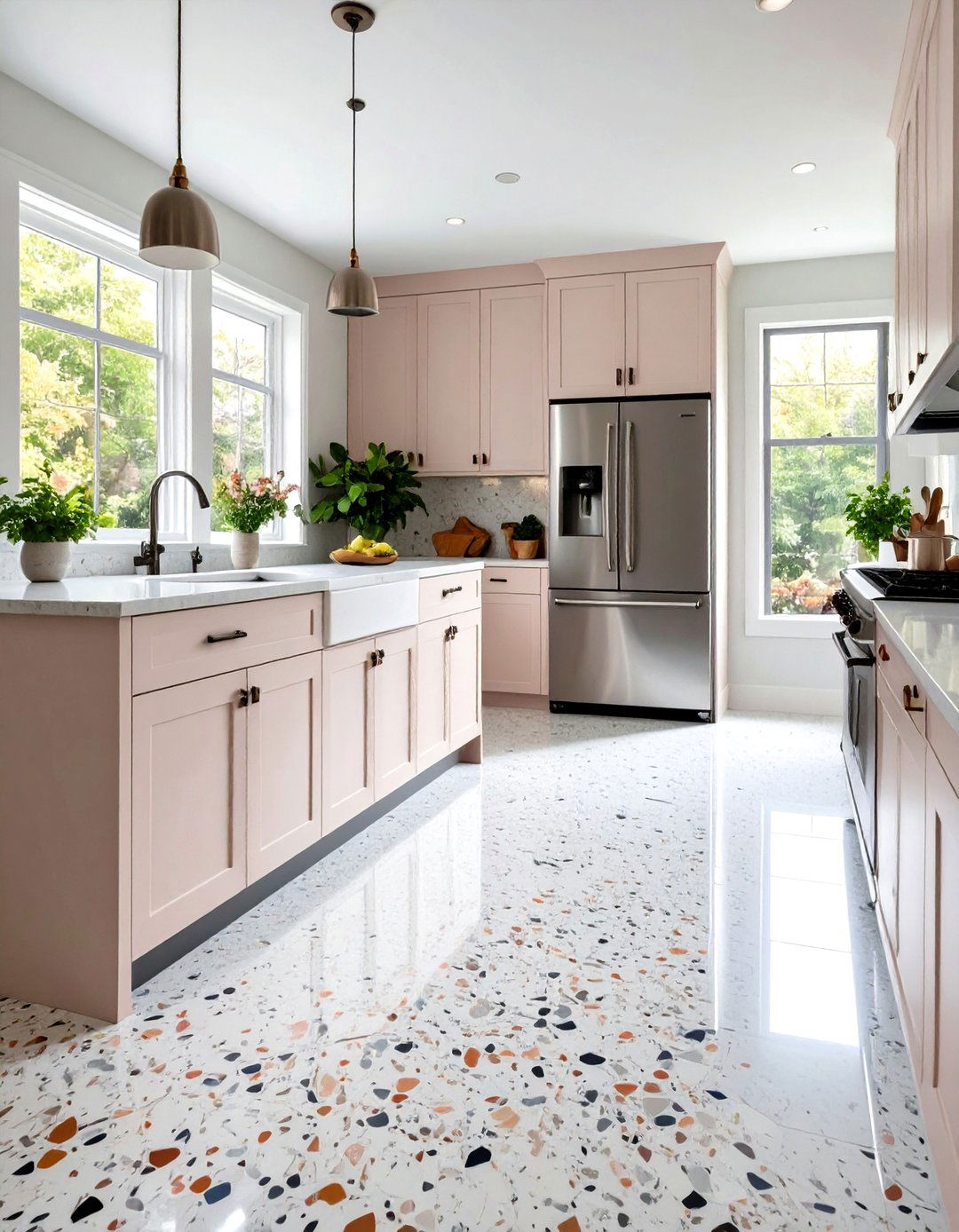
A timeless option, white terrazzo featuring oversized marble or quartz chips creates a bright, airy foundation ideal for any kitchen style. The light base reflects natural and artificial lighting, making compact kitchens feel more spacious, while the large aggregates introduce visual interest without overwhelming the space. This classic look pairs seamlessly with white or pastel cabinetry and stainless steel appliances, anchoring both traditional and contemporary designs.
2. Colored-Chip Terrazzo for Playful Vibes
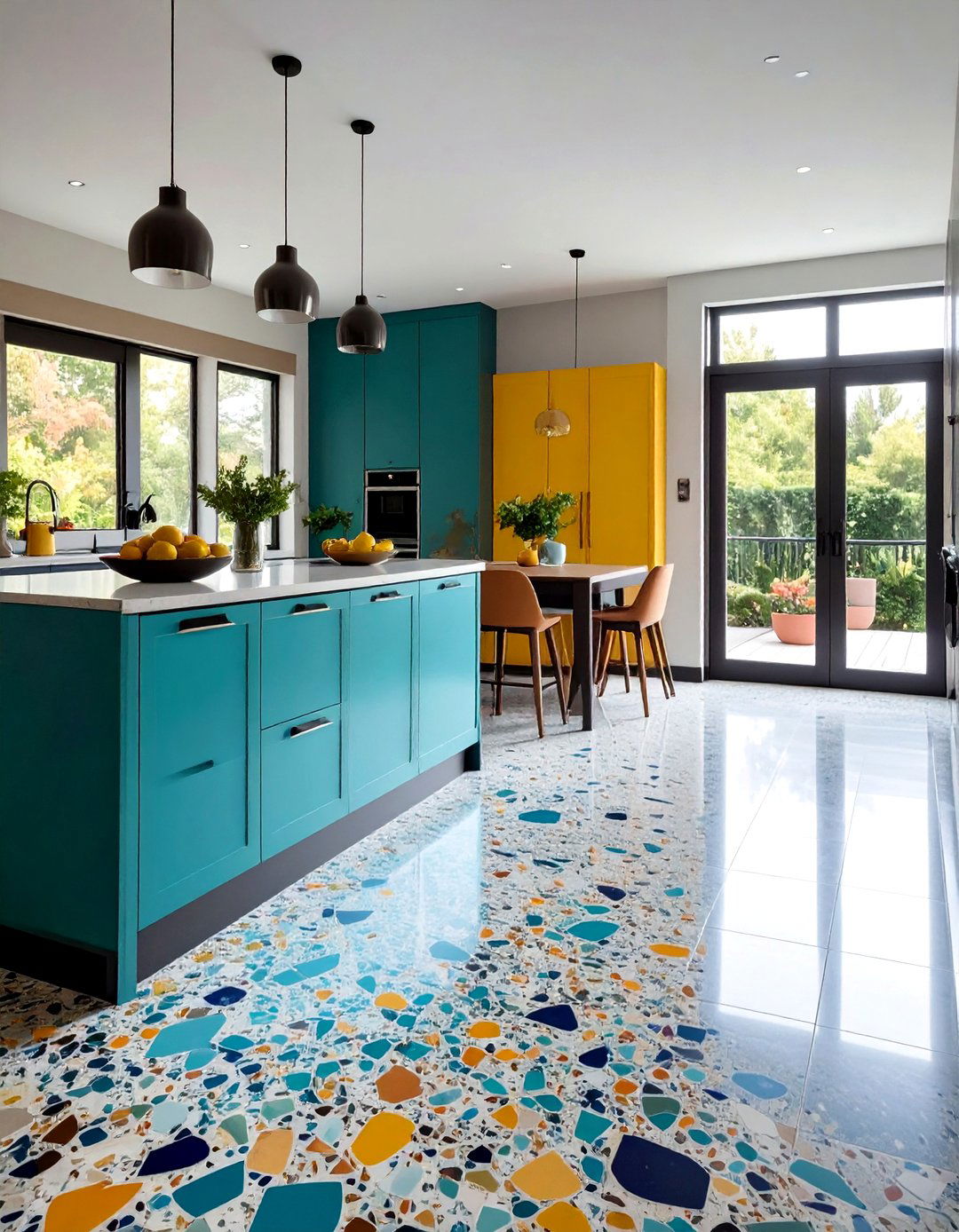
Infuse your kitchen with personality by choosing terrazzo floors embedded with vibrant glass or marble chips in hues like aqua, terracotta, or mustard. This approach transforms functional flooring into an artful focal point, especially effective in open-plan homes where the kitchen flows into living areas. Colored chips can harmonize with accent walls or barstools for a cohesive palette that feels curated and contemporary.
3. Contrasting Grout Lines to Emphasize Pattern
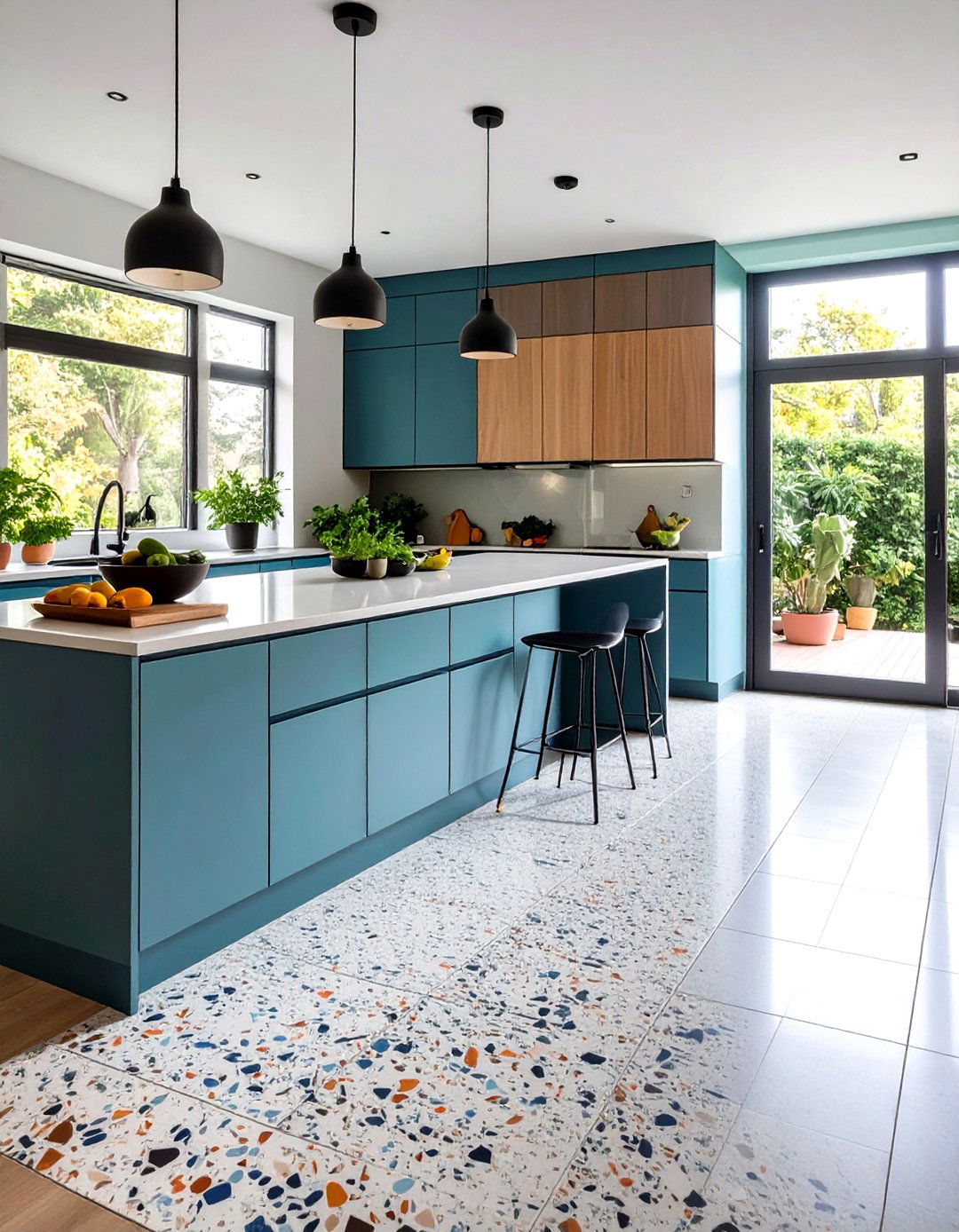
Enhance the geometric appeal of terrazzo by specifying grout lines in bold contrast—think charcoal grout against pale aggregates or white grout with dark chips. The pronounced joints accentuate each tile’s unique pattern, lending a graphic quality reminiscent of modern mosaics. This technique works particularly well with large-format terrazzo tiles, turning the floor into a dynamic grid that complements minimalist cabinetry and streamlined hardware.
4. Herringbone-Patterned Terrazzo Tiles
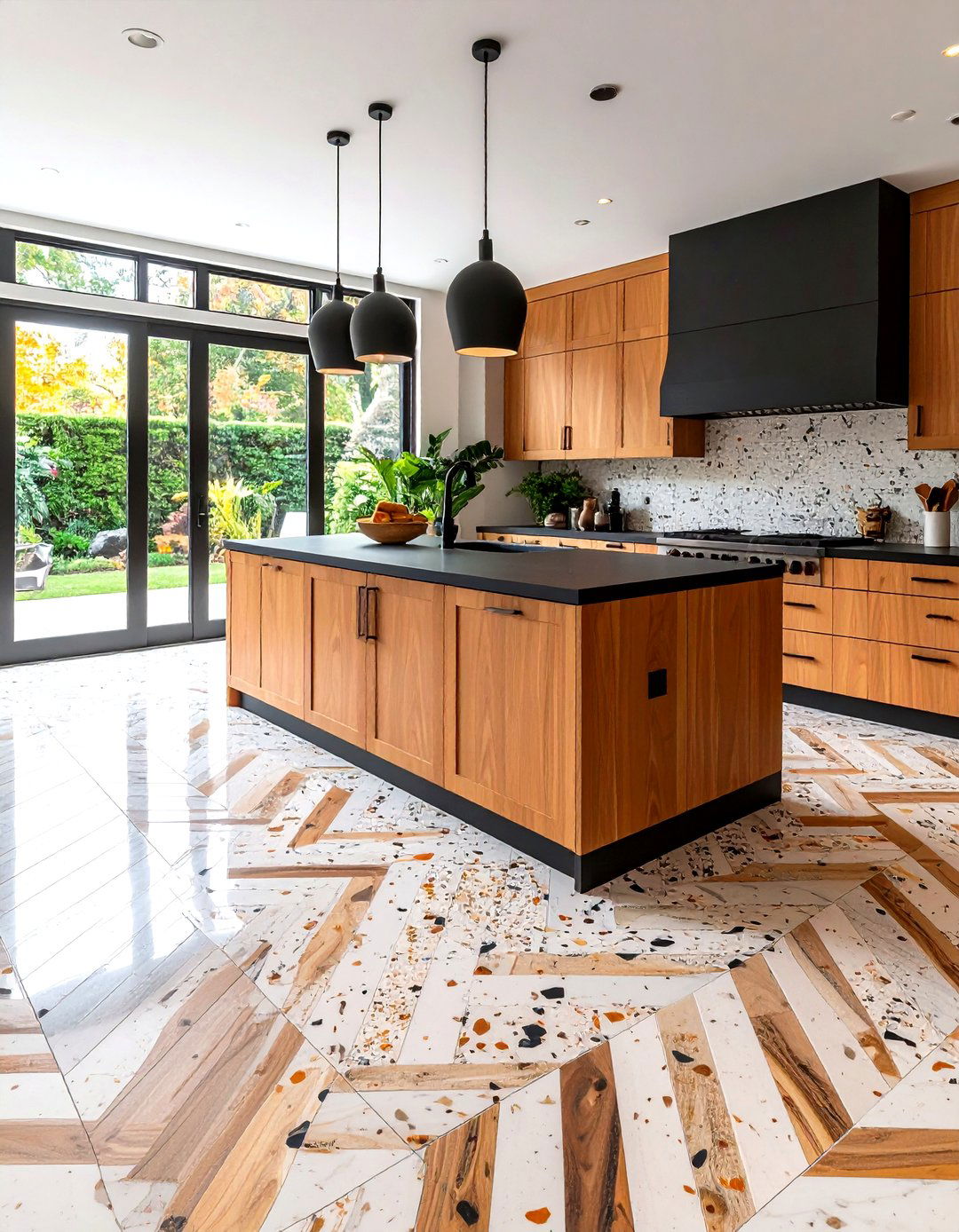
Marry classic parquet laying techniques with contemporary material by opting for herringbone-cut terrazzo planks or tiles. The zigzag arrangement introduces movement underfoot and elevates the flooring beyond a simple planar surface. Ideal for galley kitchens or narrow spaces, herringbone terrazzo elongates sightlines and adds a layer of sophistication that pairs beautifully with matte-black fixtures and warm wood accents.
5. Micro-Terrazzo Floors for Subtle Texture
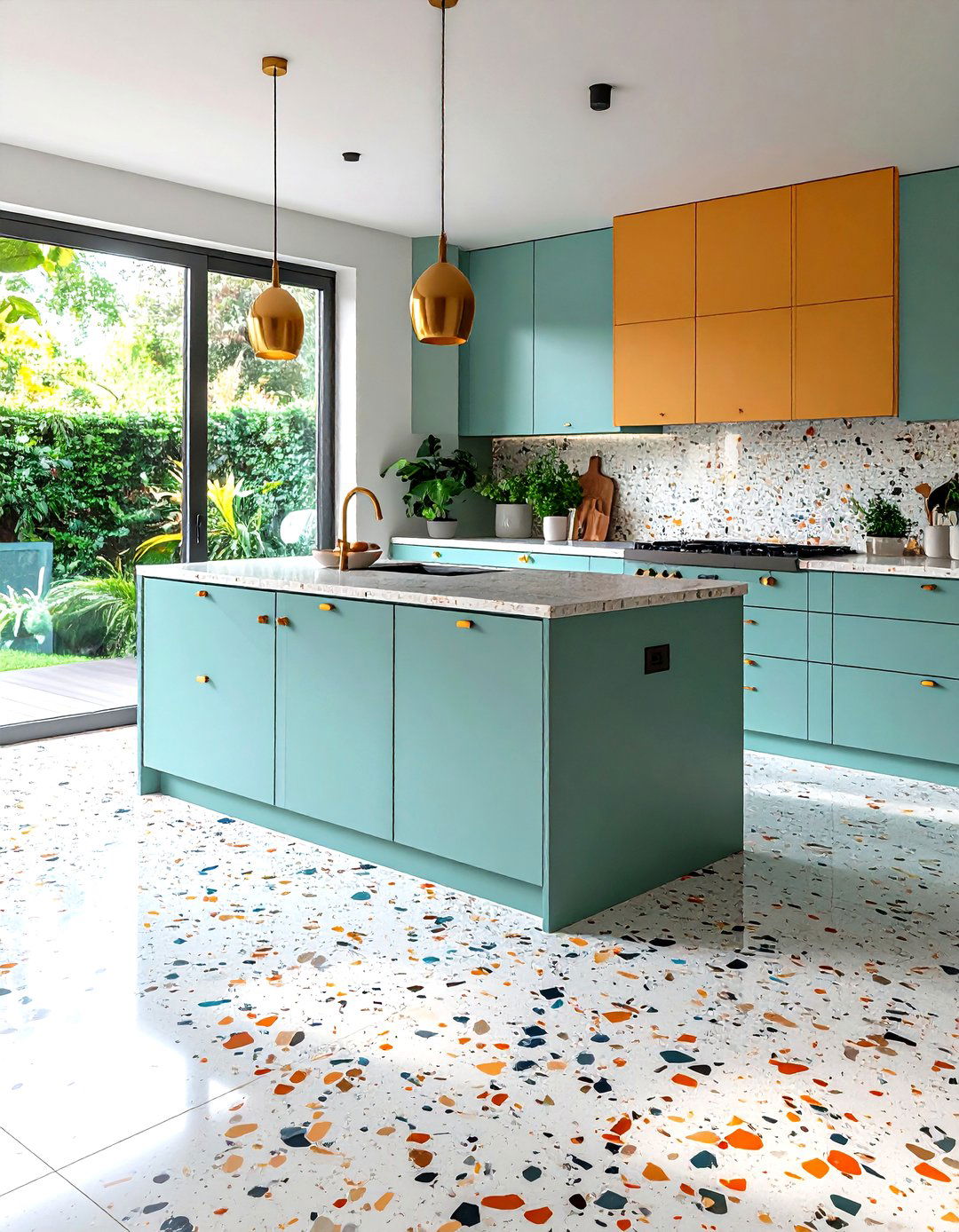
For kitchens that favor understatement, micro-terrazzo with tiny, closely spaced chips delivers a refined, nearly uniform surface texture. The subtle speckling provides just enough visual depth to hide minor wear and tear without detracting from bold cabinetry or statement lighting. Micro-terrazzo’s restrained aesthetic suits monochrome palettes and Scandinavian-inspired decor, offering practicality and gentle pattern in equal measure.
6. Bold Monochrome Terrazzo Flooring

Embrace high contrast with black-and-white terrazzo floors, where dark cementitious binders showcase white marble chips—creating a dramatic checkerboard effect without separate tiles. This approach unifies adjacent rooms when extended beyond the kitchen, crafting a cohesive flow in open-plan homes. Pair with brass hardware and deep-hued cabinetry to amplify the floor’s graphic impact, or soften the scheme with pale wood islands and neutral textiles.
7. Pastel Terrazzo for Soft Aesthetics
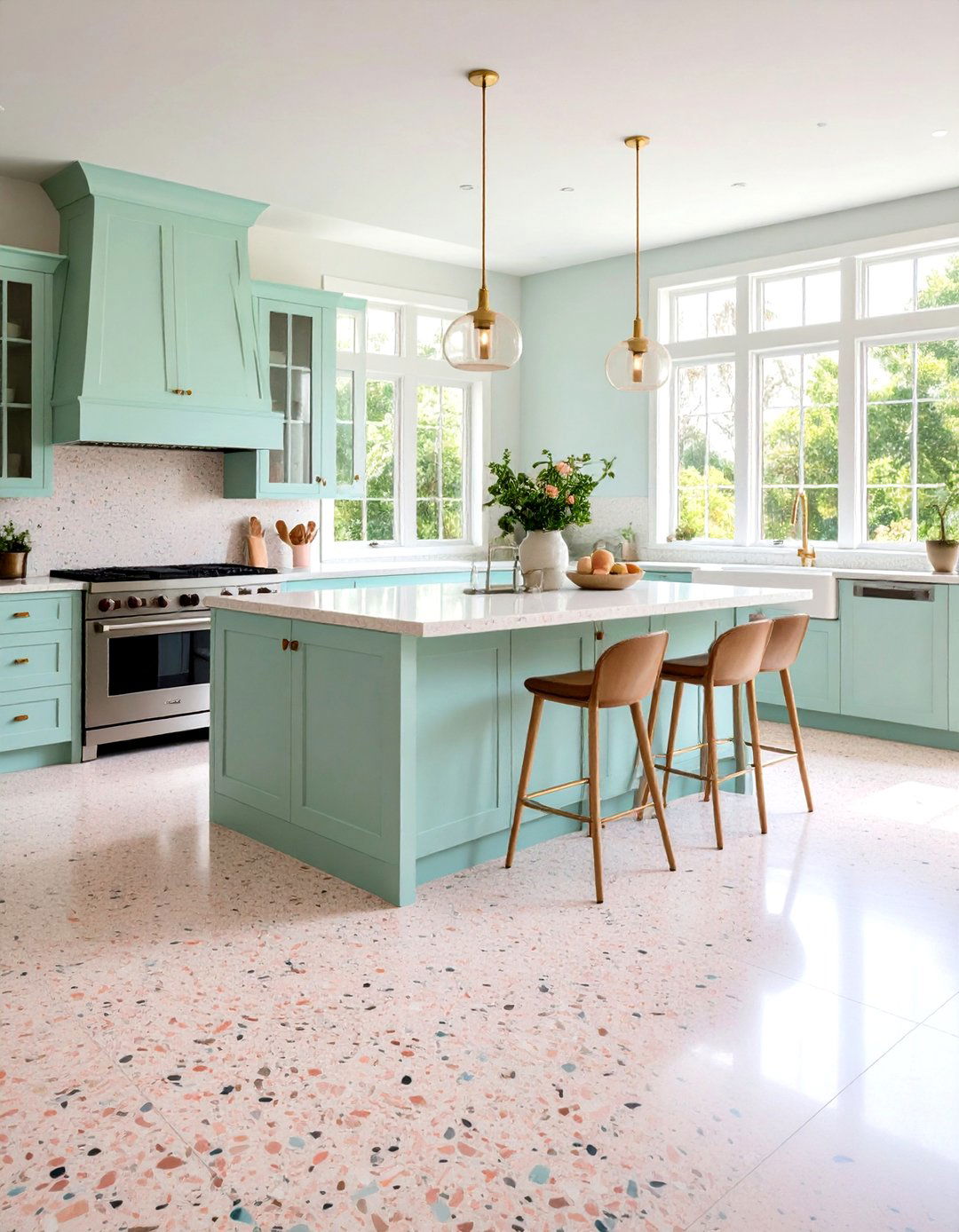
Pastel terrazzo floors, incorporating chips in blush pink, mint green, or powder blue, introduce a gentle pop of color that brightens kitchens without overpowering them. This palette harmonizes with white marble countertops and light wood cabinets, infusing a vintage-inspired yet modern feel. Ideal for cottage-style or coastal kitchens, pastel terrazzo provides a cheerful foundation that ties together subtle accents like ceramic pitchers or woven rugs.
8. Luxe Polished Terrazzo for High Shine
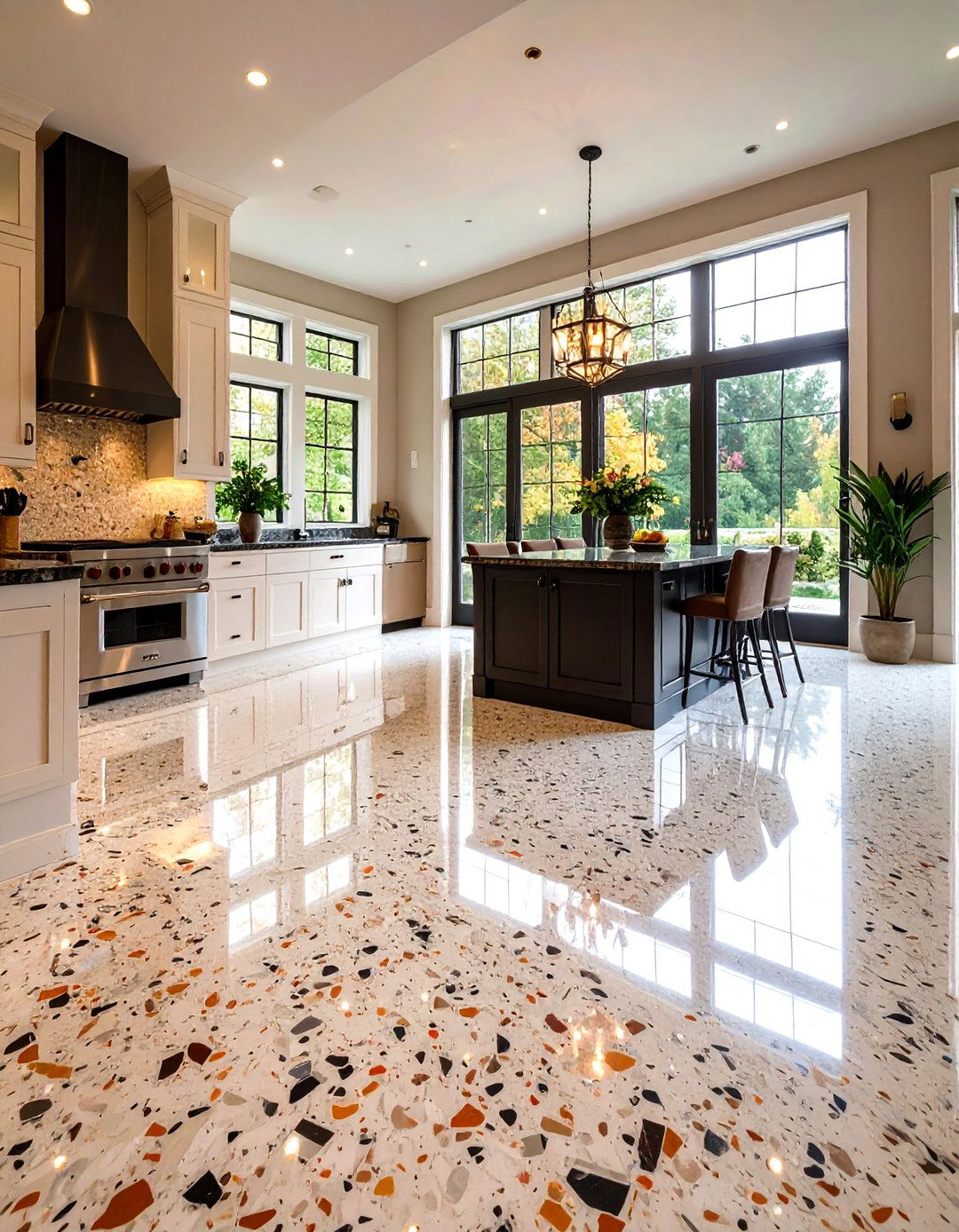
Opt for a mirror-like polished terrazzo finish to lend kitchens a touch of luxury akin to polished marble. The intensified sheen amplifies light reflection and showcases the natural beauty of each aggregate, turning the floor into a statement surface. Polished terrazzo withstands heavy foot traffic and resists stains when properly sealed—making it both glamorous and practical for busy culinary spaces.
9. Matte-Finish Terrazzo for Modern Minimalism
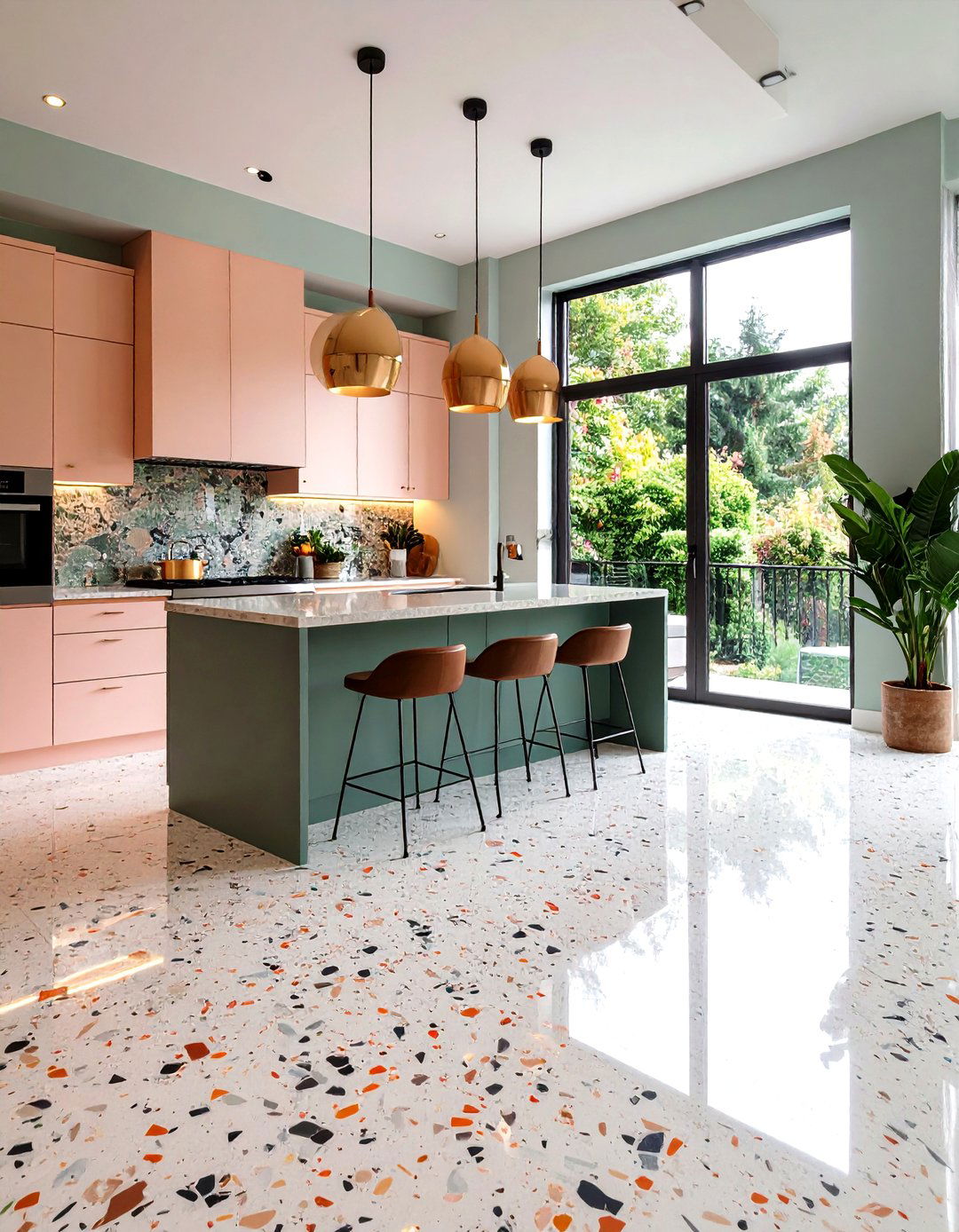
For a contemporary, subdued look, select terrazzo with a matte finish that mutes reflections and offers a soft tactile feel underfoot. This finish emphasizes the stone chips’ textures and integrates seamlessly with matte cabinetry and hardware. Matte terrazzo resists the scuffing that can show on glossy floors, maintaining a pristine look in high-use kitchens while supporting minimalist design schemes.
10. Recycled-Glass Terrazzo for Eco-Friendly Choice

Champion sustainability by choosing terrazzo made with recycled glass aggregates—often sourced from bottles or windows—set in a cementitious or resin binder. The resulting floor sparkles with flecks of translucent color, offering a unique visual depth. Beyond its ecological benefits, recycled-glass terrazzo is highly durable and easy to maintain, aligning with green building certifications and health-conscious design goals.
11. Large-Scale Aggregate Terrazzo
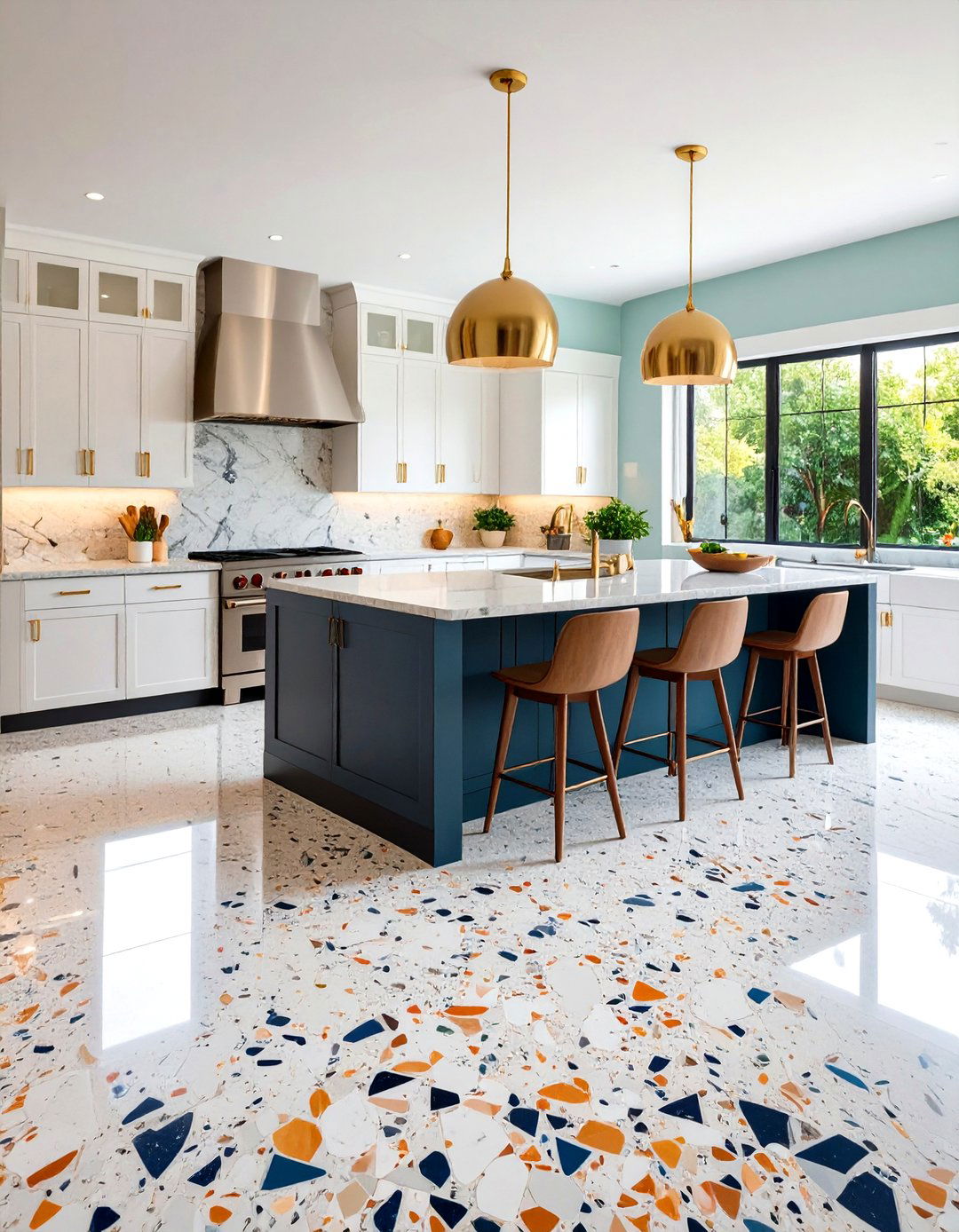
Inspired by Max Lamb’s Marmoreal, select large, irregular marble chunks for a bold, sculptural terrazzo floor. The oversized aggregates create a mosaic-like effect that reads almost like an abstract painting underfoot. This approach emphasizes the material’s raw beauty and historic craftsmanship, ideal for statement kitchens in loft conversions or high-end renovations seeking a gallery-like ambiance.
12. Patterned-Inlay Terrazzo Borders
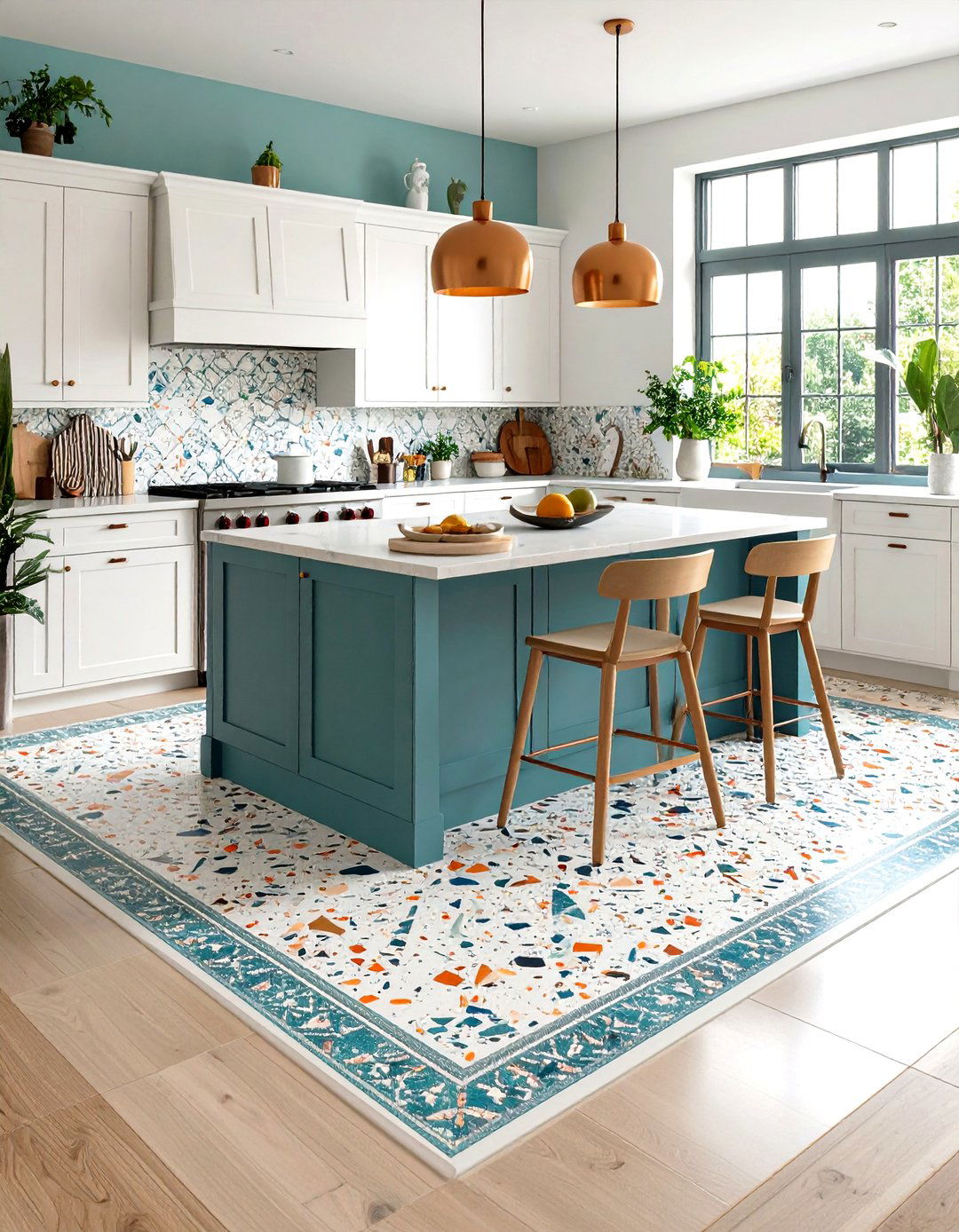
Frame your kitchen floor with inlaid terrazzo borders that feature contrasting chip colors or geometric motifs. Metal strips or thin grout channels can delineate the inlay, creating a picture-frame effect that defines the cooking zone. This technique adds architectural detail and can mirror patterns found in cabinetry or ceiling beams, unifying disparate design elements.
13. Bi-Color Split Terrazzo Floors
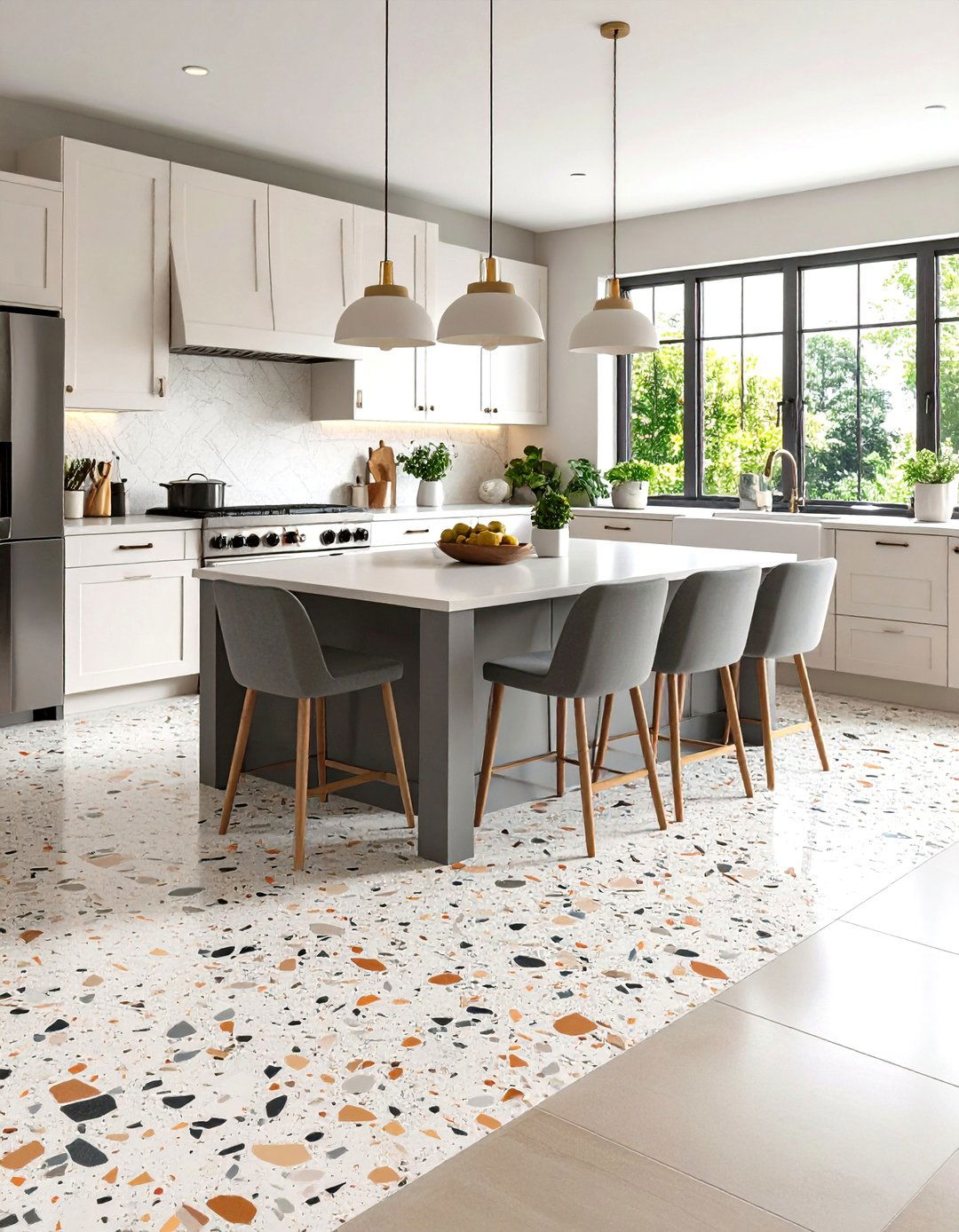
Divide the floor plane into two complementary terrazzo colors—such as warm beige and cool gray—separated by a crisp grout line. The bi-color split can reflect the kitchen’s zoning (prep versus dining) or create dynamic visual interest in open-plan layouts. This dual-tone strategy allows you to balance neutral cabinetry with accent walls, forging a tailored look.
14. Terrazzo and Wood Transition Floors
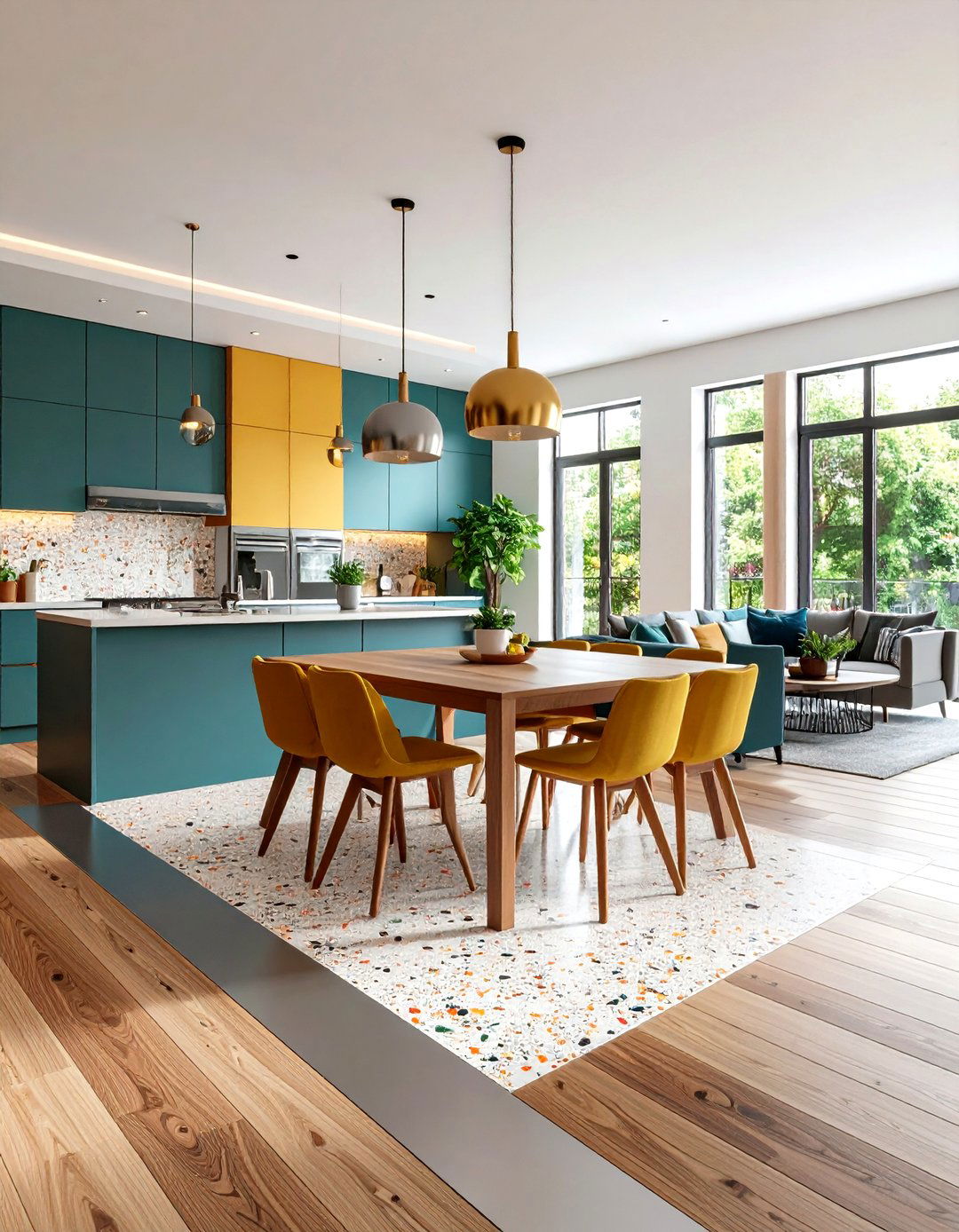
Seamlessly bridge kitchen and living areas by pairing terrazzo flooring with adjoining hardwood, using zinc or brass transition strips. The metallic divider highlights the material change while maintaining visual continuity. This hybrid approach works especially well in homes that mix historic and contemporary elements, providing warmth from the wood and durability from the terrazzo.
15. Terrazzo Island Accents

Instead of a full-floor installation, use terrazzo as the surface for a kitchen island or peninsula. The terrazzo top contrasts with the surrounding flooring—whether hardwood or tile—creating a sculptural centerpiece. Choose aggregates that pick up accent colors in cabinet hardware or light fixtures to reinforce a unified palette in the room.
16. Terrazzo Backsplash-to-Floor Continuum
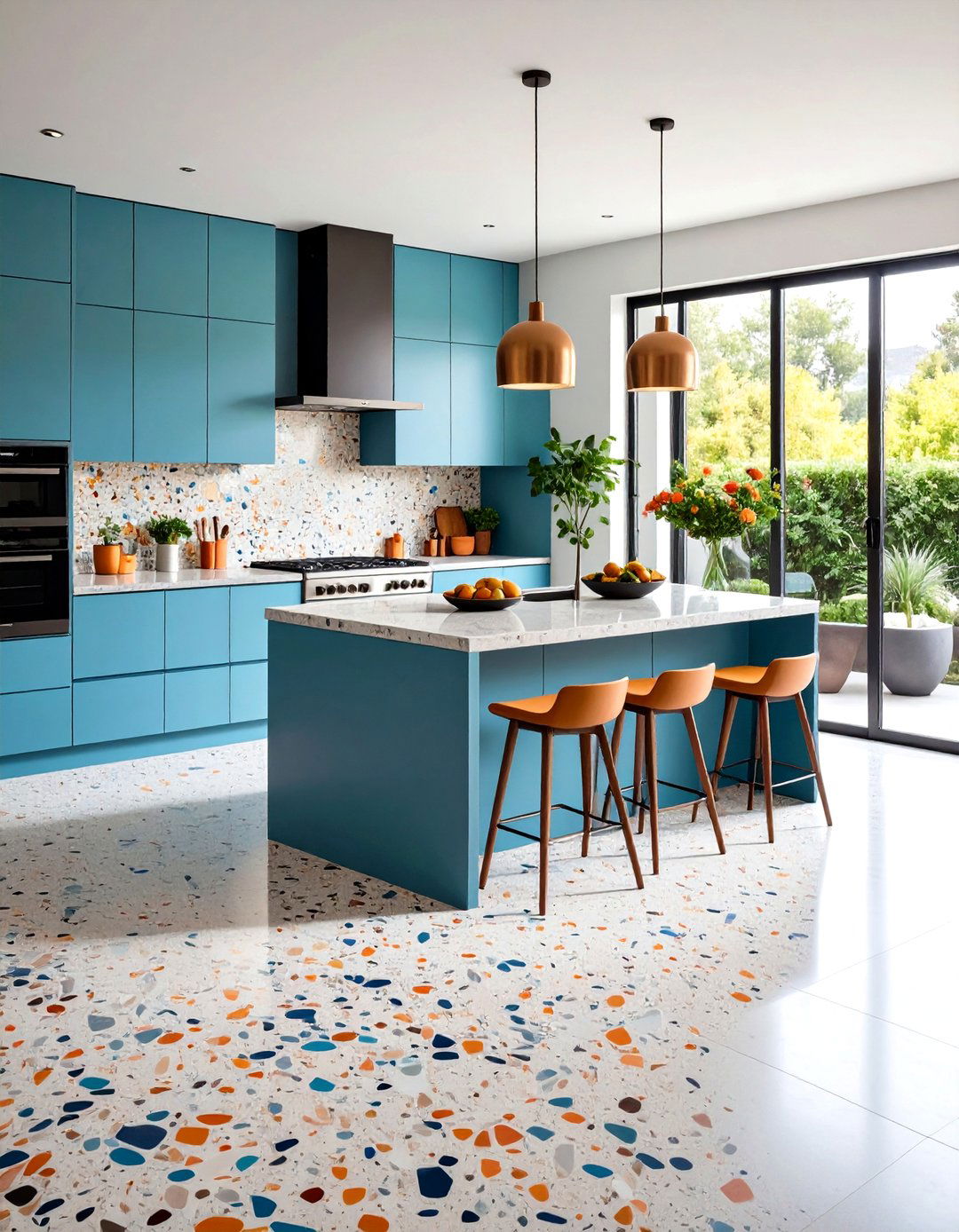
Extend terrazzo from the floor up the backsplash for a monolithic, immersive look that blurs horizontal and vertical boundaries. This continuous surface treatment bathes the kitchen in cohesive pattern and texture, ideal for contemporary and industrial styles. Coupled with minimalistic cabinetry, the terrazzo becomes the star, requiring little additional ornamentation.
17. Dark Terrazzo for Dramatic Impact
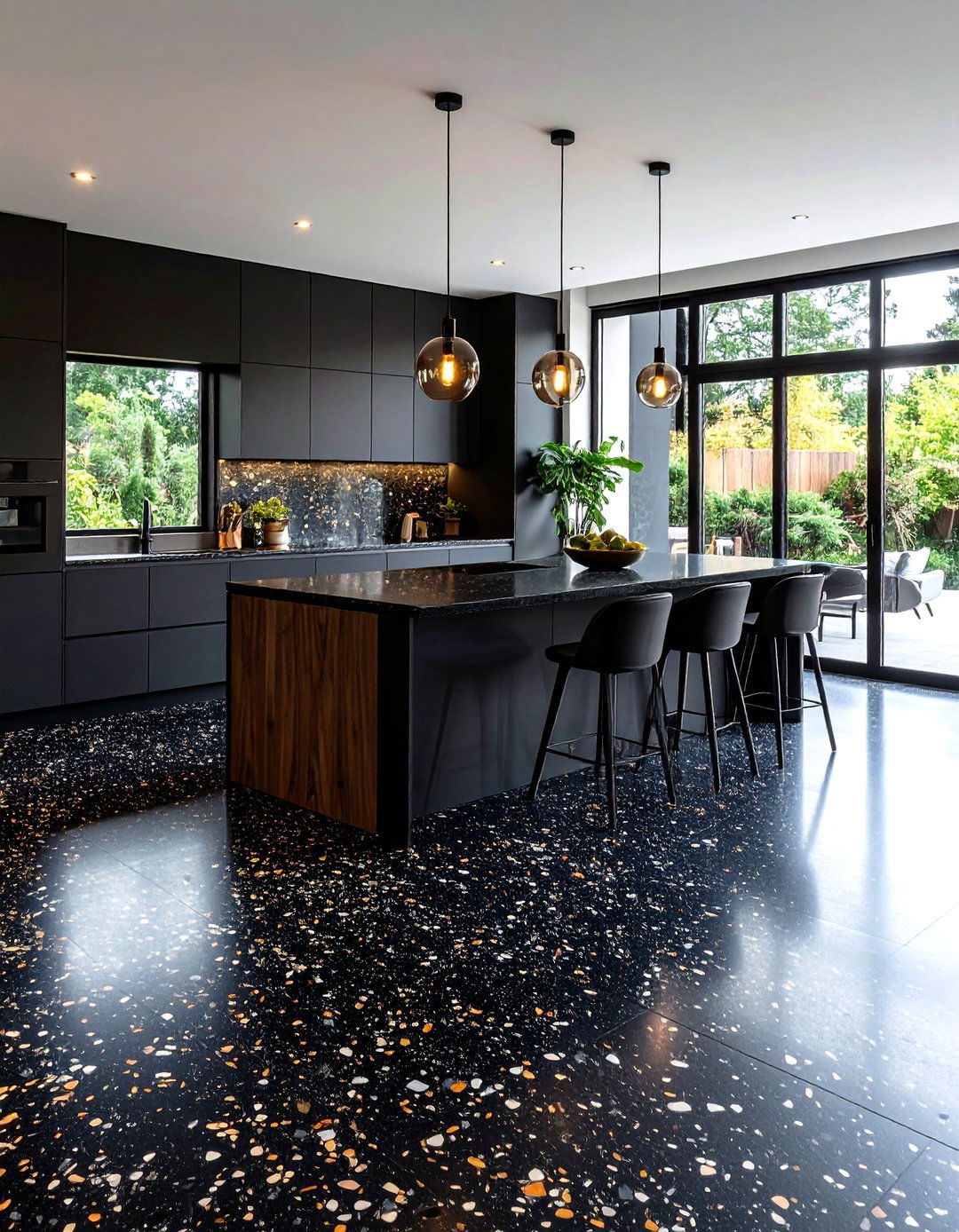
Choose a deep charcoal or espresso binder with contrasting light chips to introduce drama into spacious kitchens. Dark terrazzo grounds expansive layouts and highlights lighter cabinetry or metallic accents. Its forgiving nature camouflages everyday spills and scuffs, making it both stylish and forgiving in high-traffic culinary environments.
18. Geometric Terrazzo Patterns
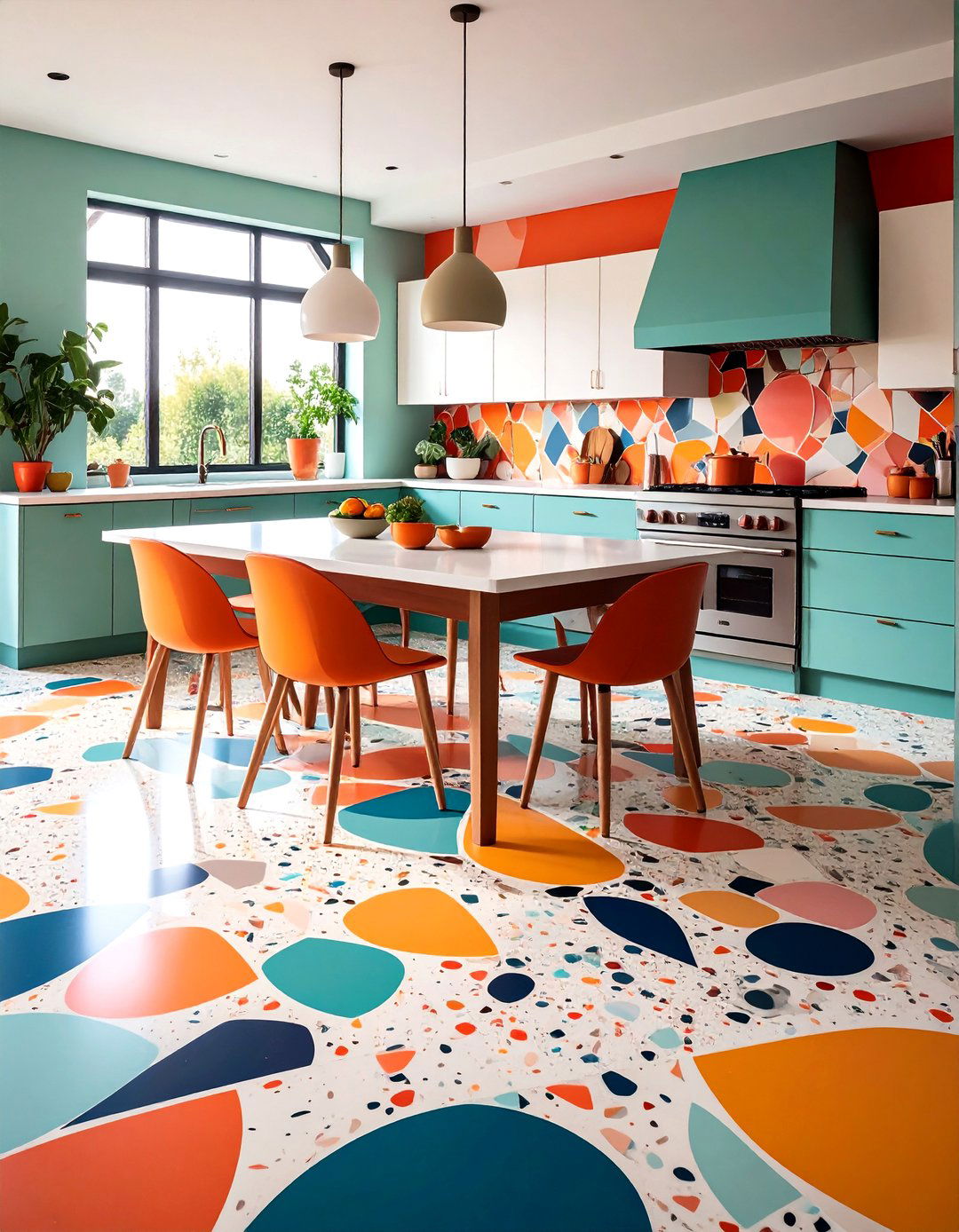
Take inspiration from contemporary art by arranging terrazzo pieces in abstract, landscape-like patterns using large breccia inlays and gray grout. This sculptural approach, as seen in a Moscow townhouse renovation, transforms floors into bespoke canvases that echo surrounding curved walls and minimalist decor.
19. Inlaid Metal-Strip Accents
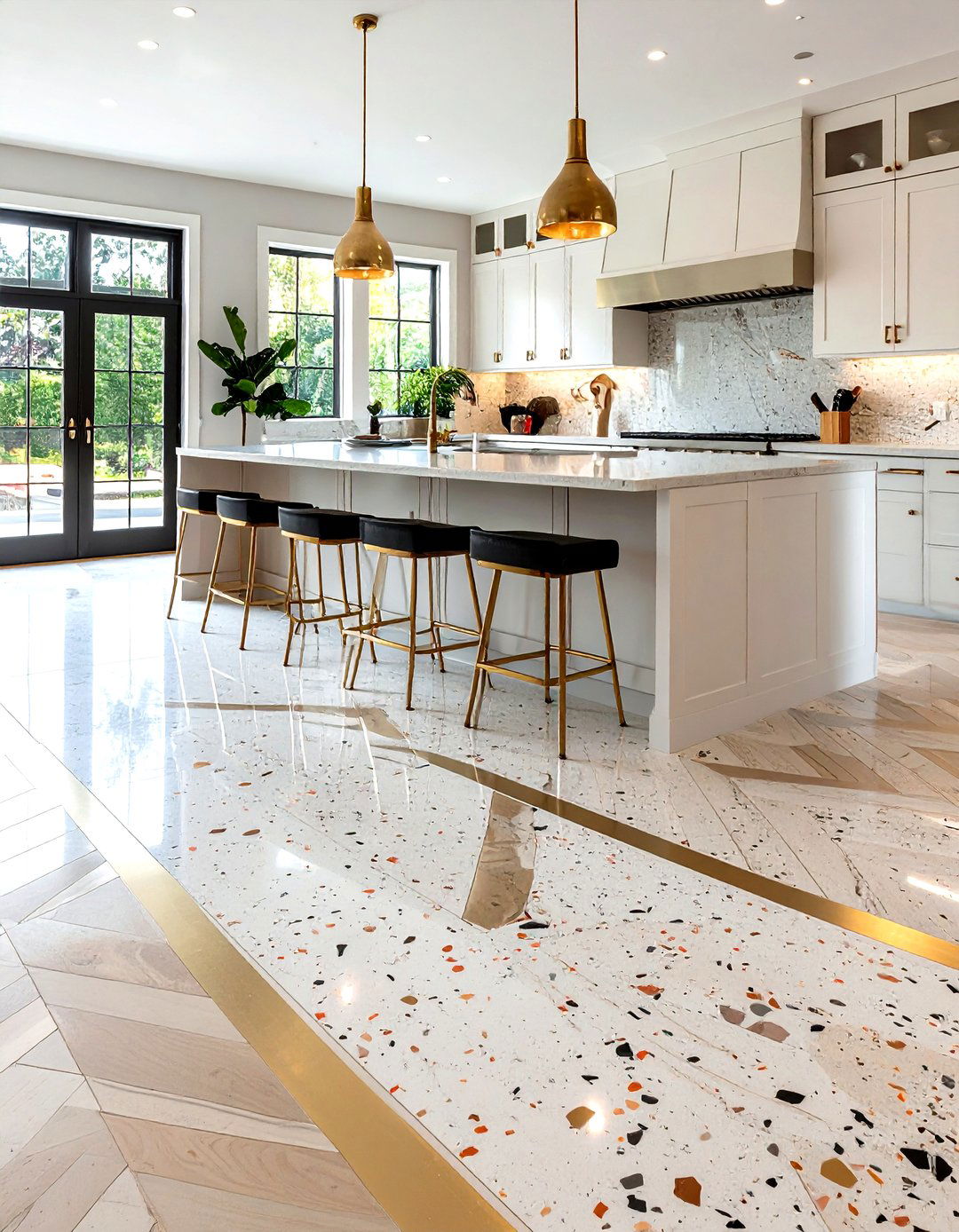
Incorporate slim brass or stainless-steel strips within the terrazzo pour to form linear accents or chevron patterns. These metallic lines catch light and introduce a luxe detail that complements hardware finishes on cabinetry and fixtures—bridging the gap between floor and furnishings.
20. Indoor-Outdoor Terrazzo for Seamless Flow
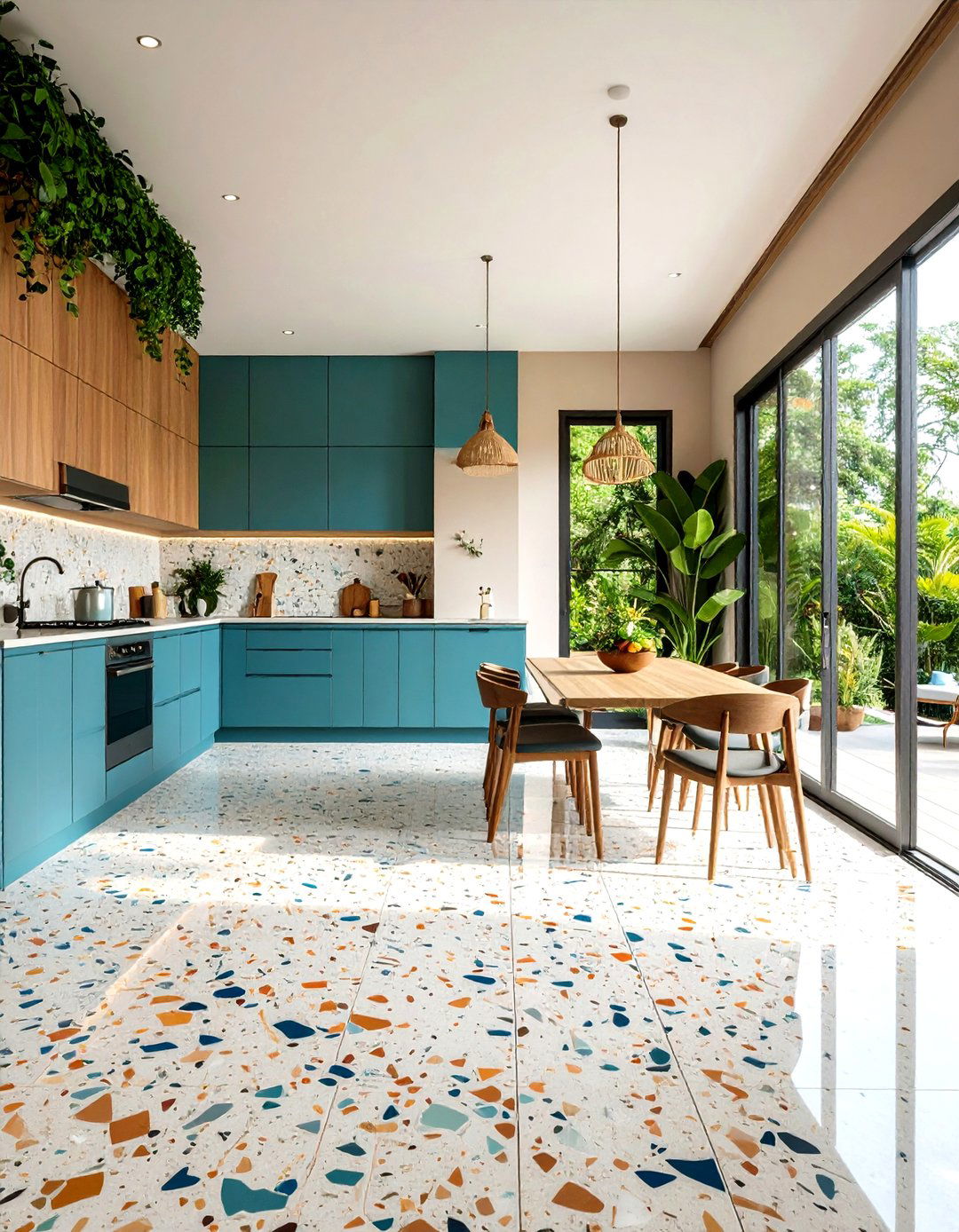
Use durable, weather-resistant terrazzo suitable for both interior and exterior to create a continuous floor from the kitchen out to a patio or courtyard. This seamless transition expands living space visually and functionally, ideal for climates where alfresco dining is a daily ritual.
Conclusion:
Terrazzo kitchen floors offer an extraordinary blend of durability, versatility, and artistry. From bold monochrome statements to soft pastel palettes, micro-terrazzo textures to large-scale aggregates, there’s a design to suit every aesthetic and functional requirement. Whether you opt for a full-floor installation, an accent island, or a continuous backsplash-floor treatment, terrazzo brings timeless elegance and customizable character to modern kitchens. By exploring contrasting patterns, inlaid borders, or recycled materials, you can craft a uniquely personal space that marries practical resilience with unmistakable style. Enjoy the process of selecting the perfect terrazzo scheme for your culinary haven!


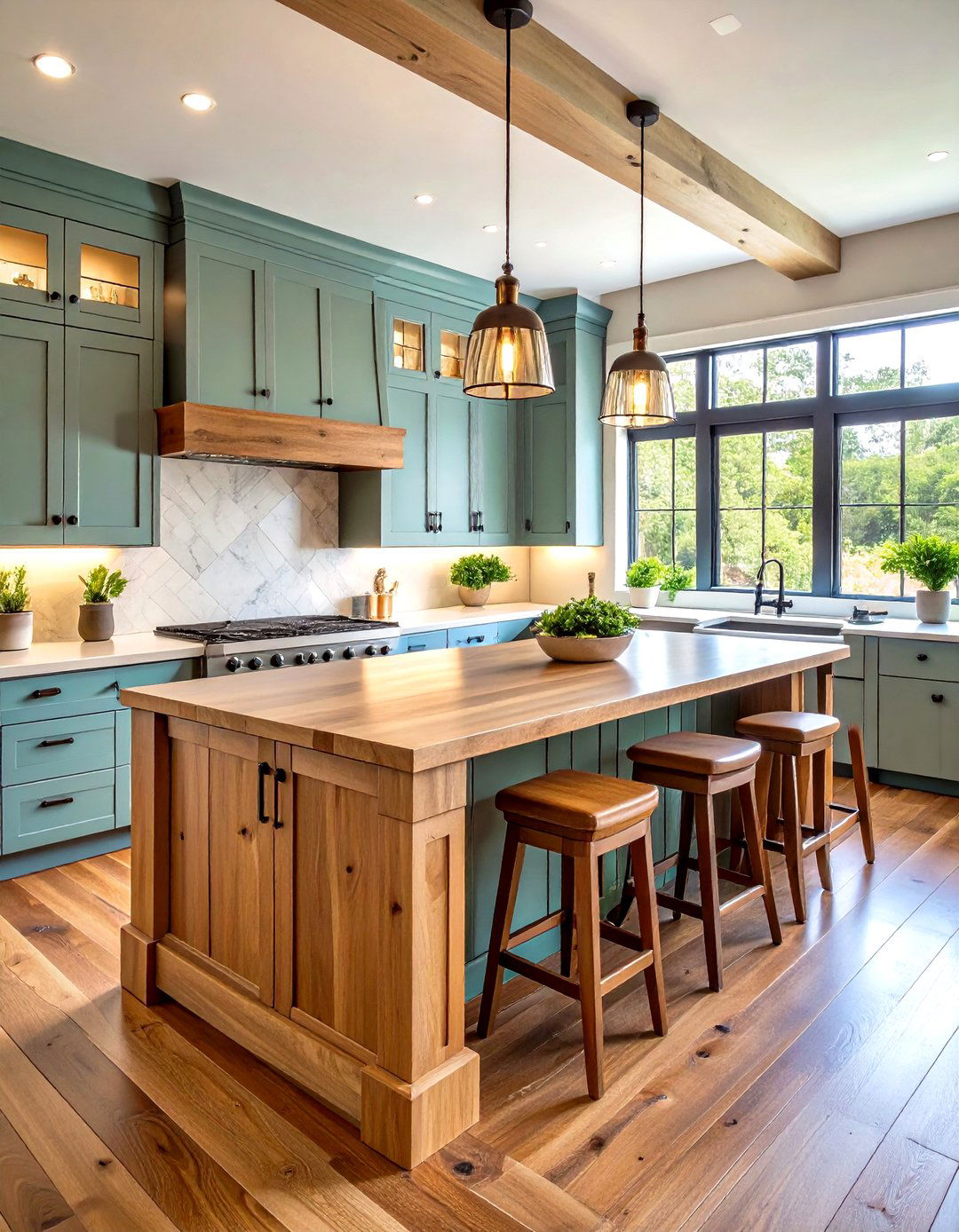

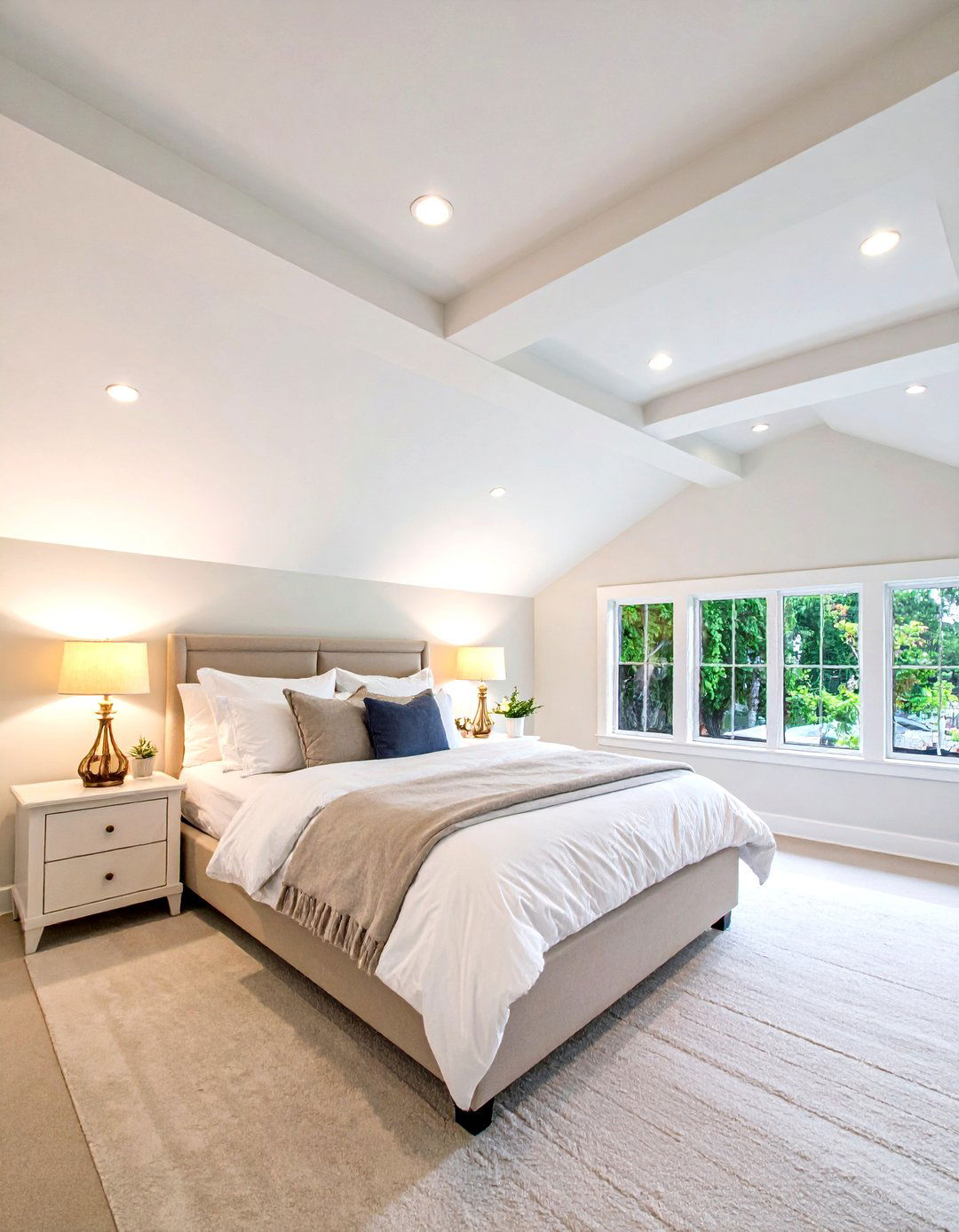
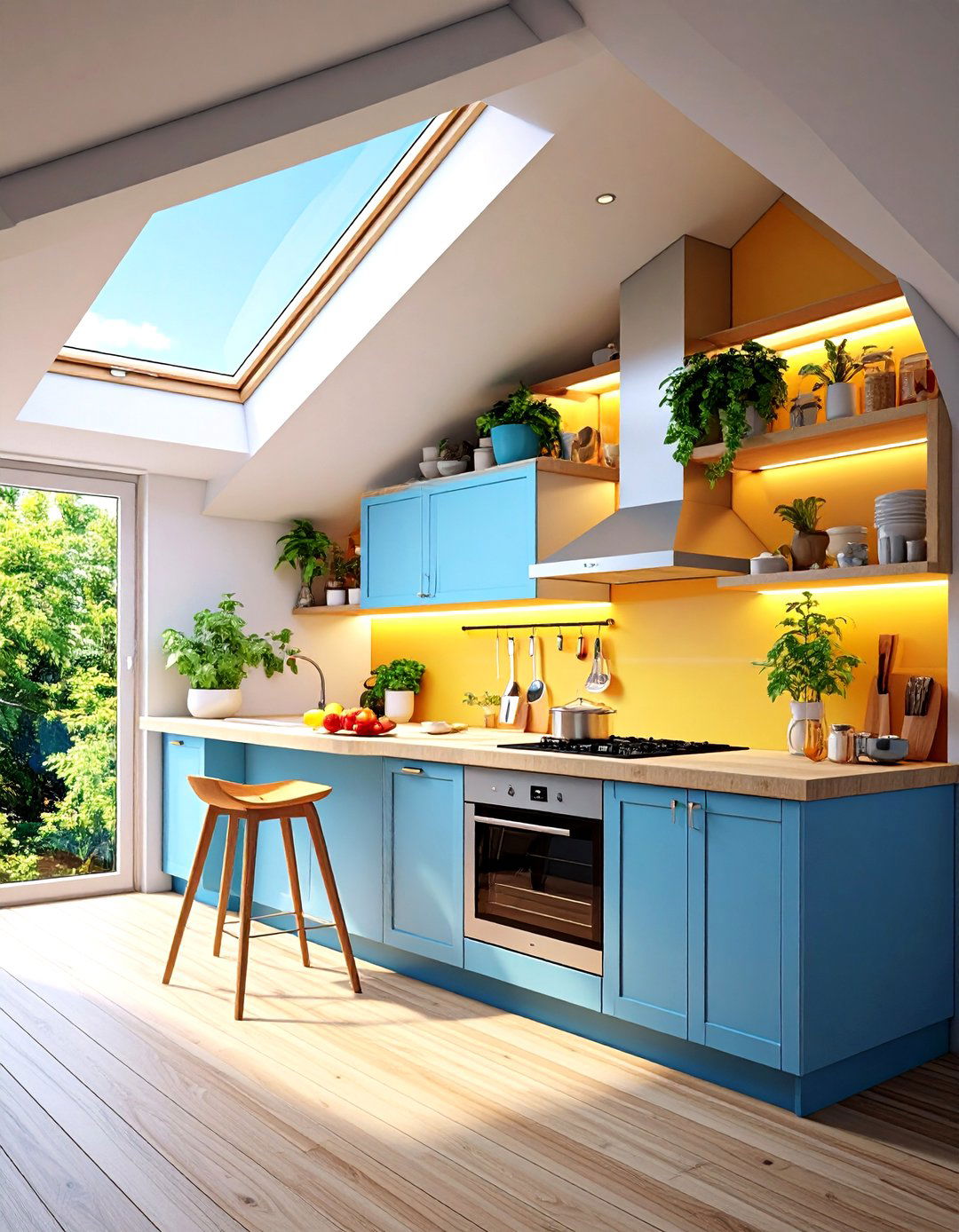
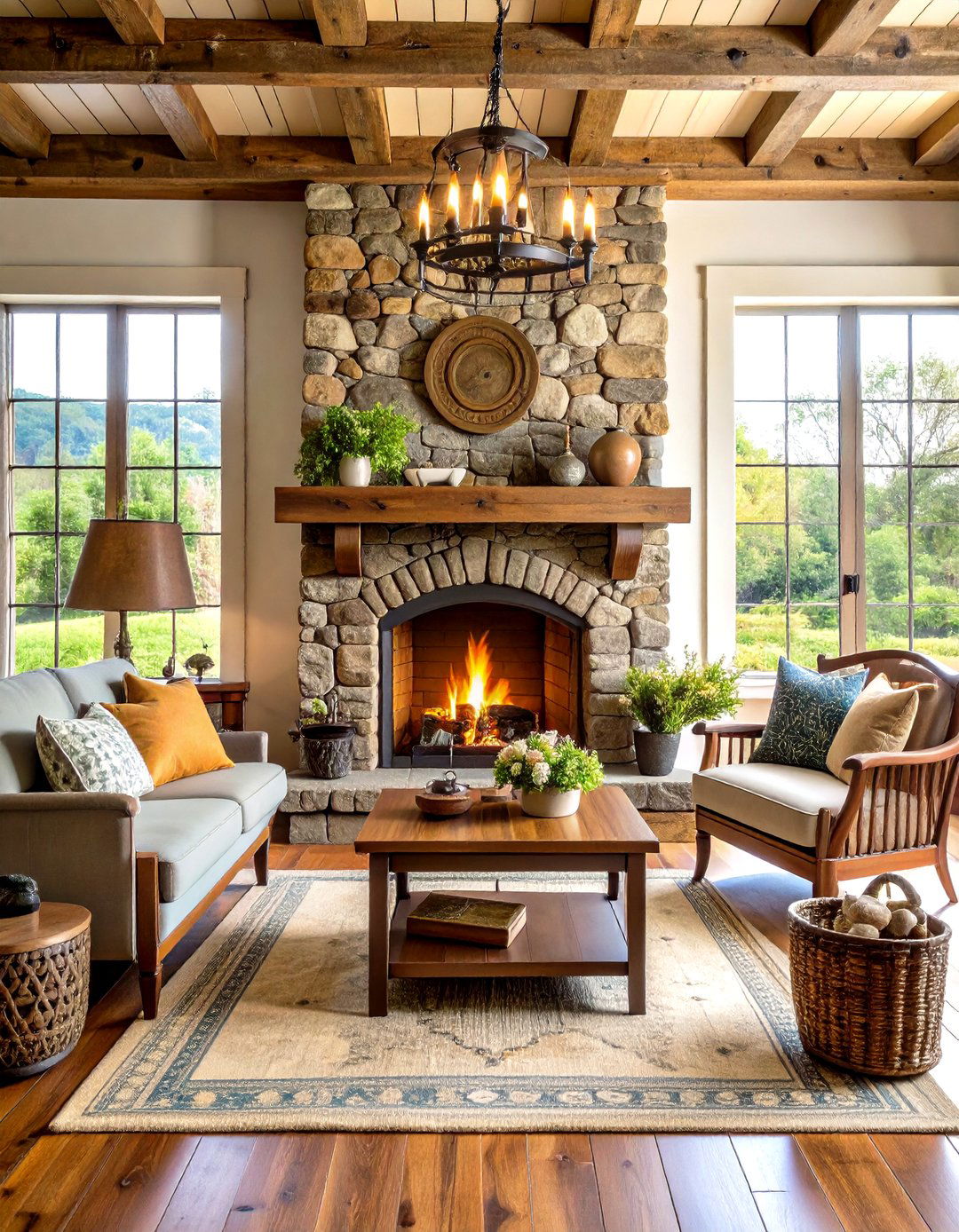
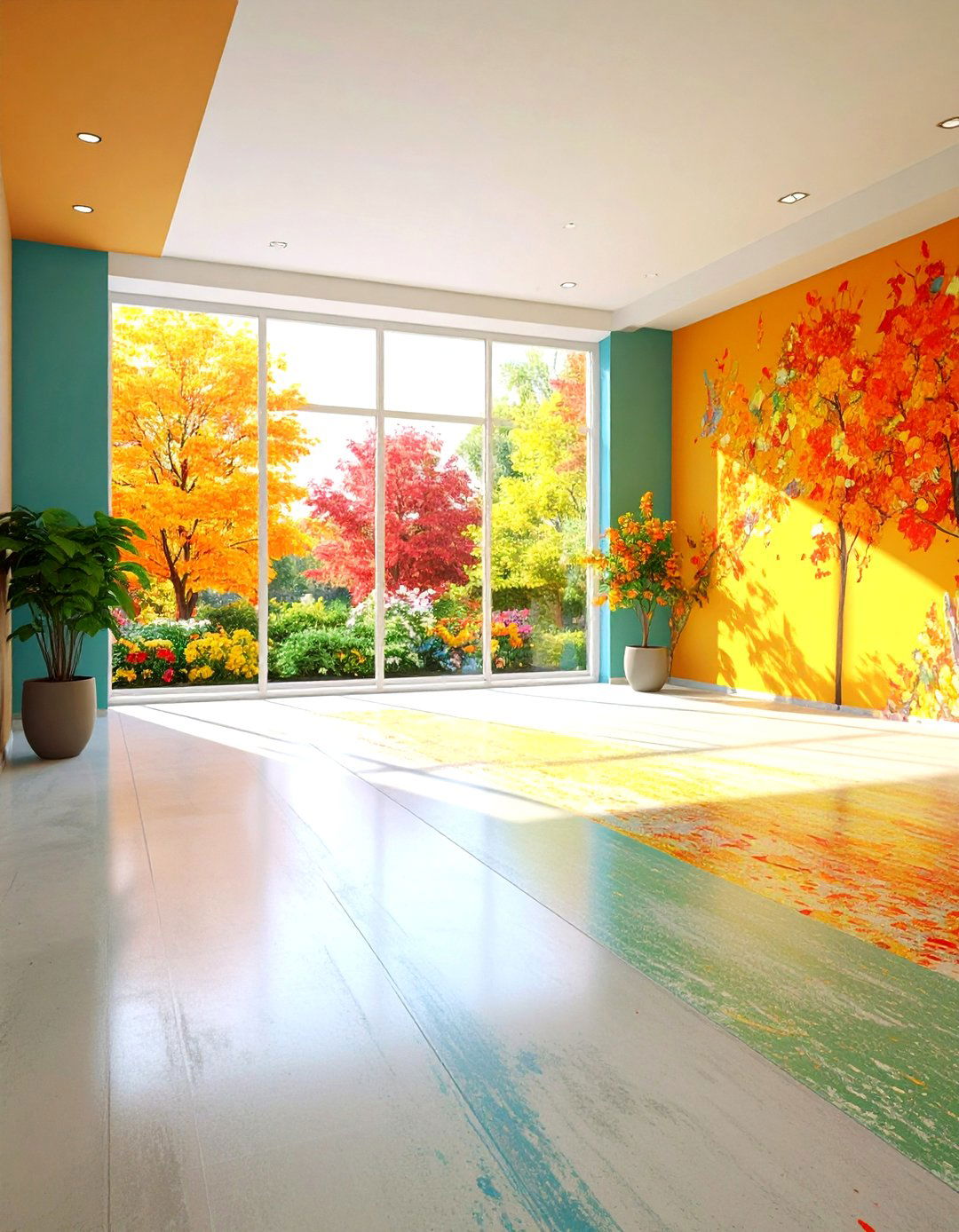
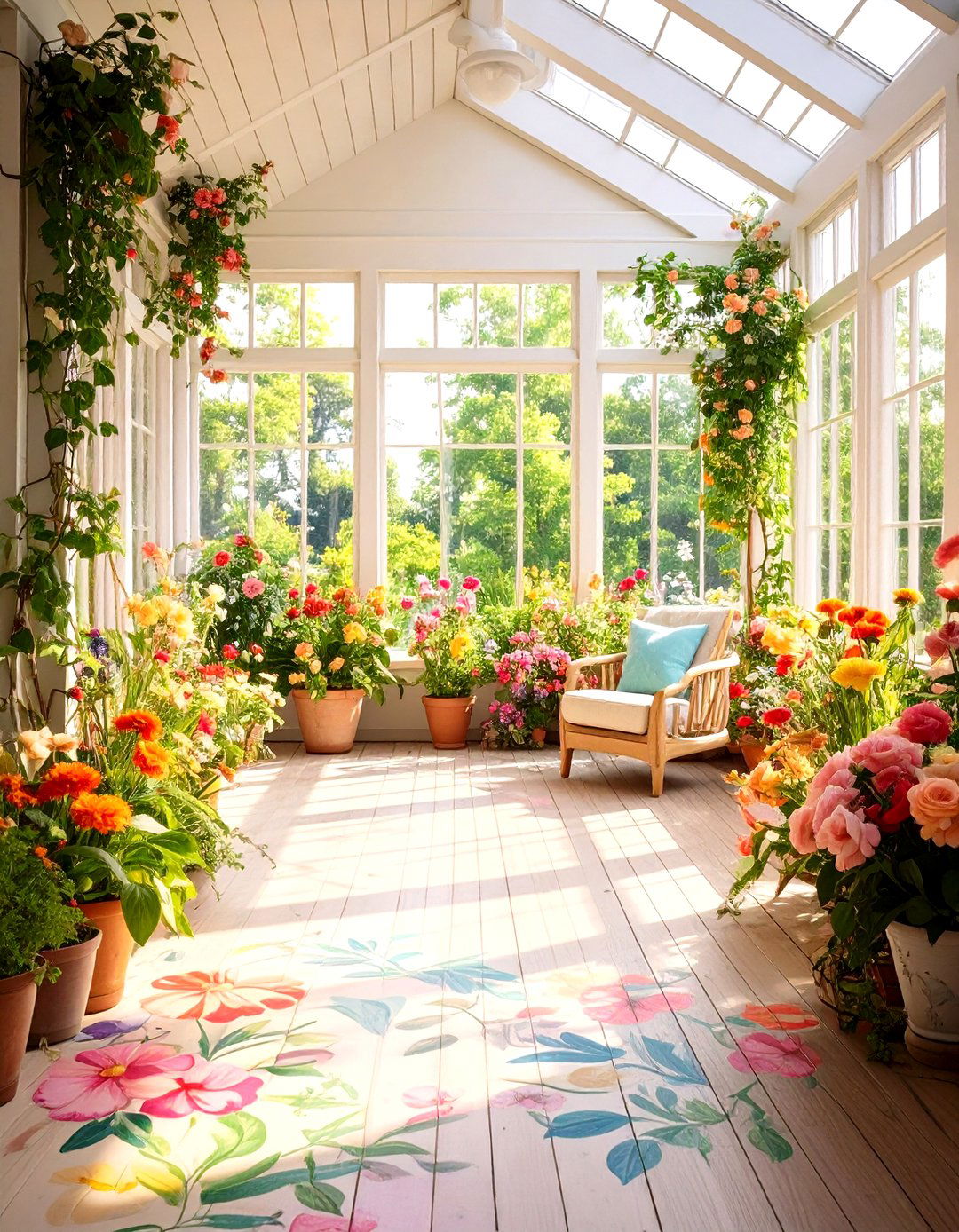
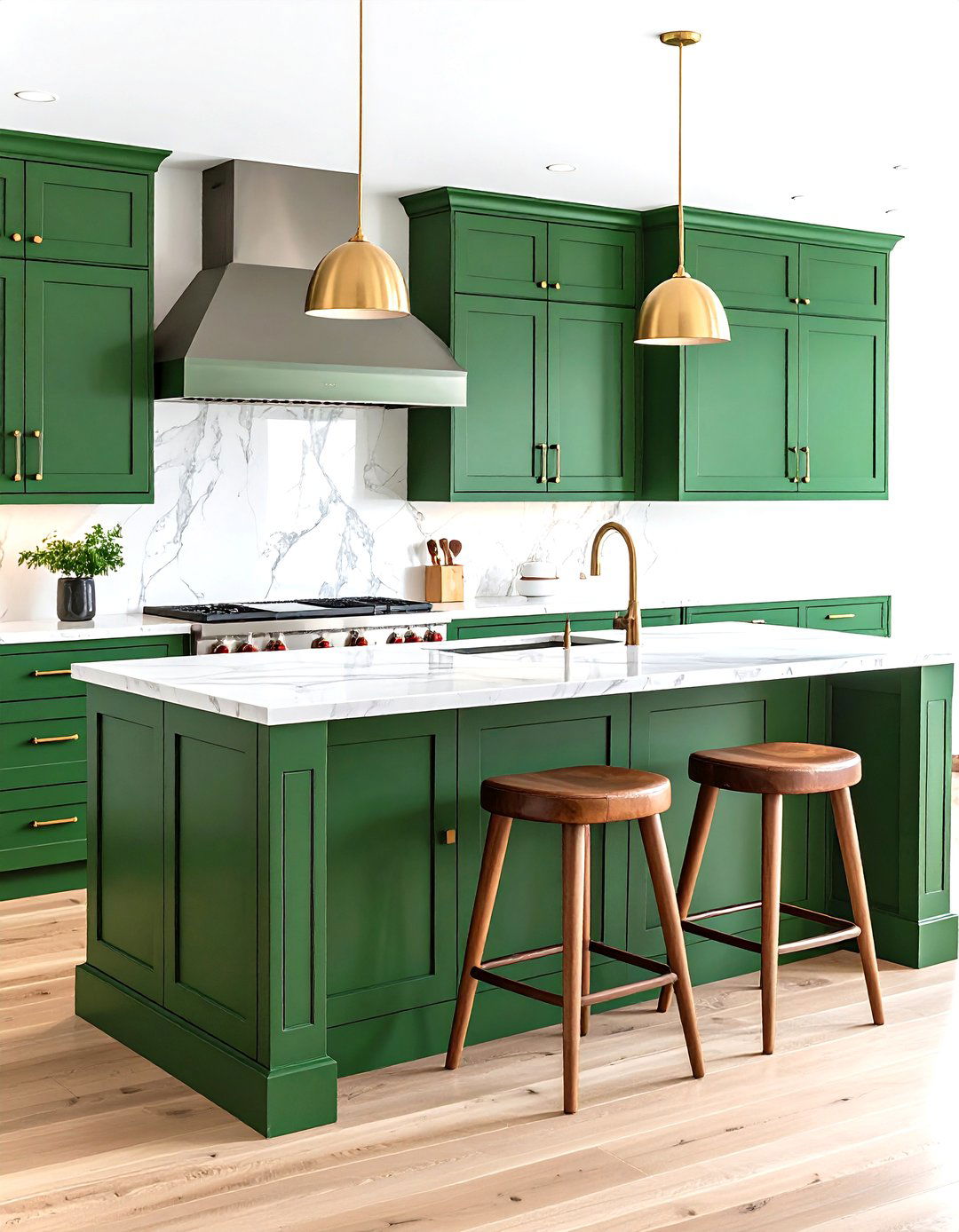
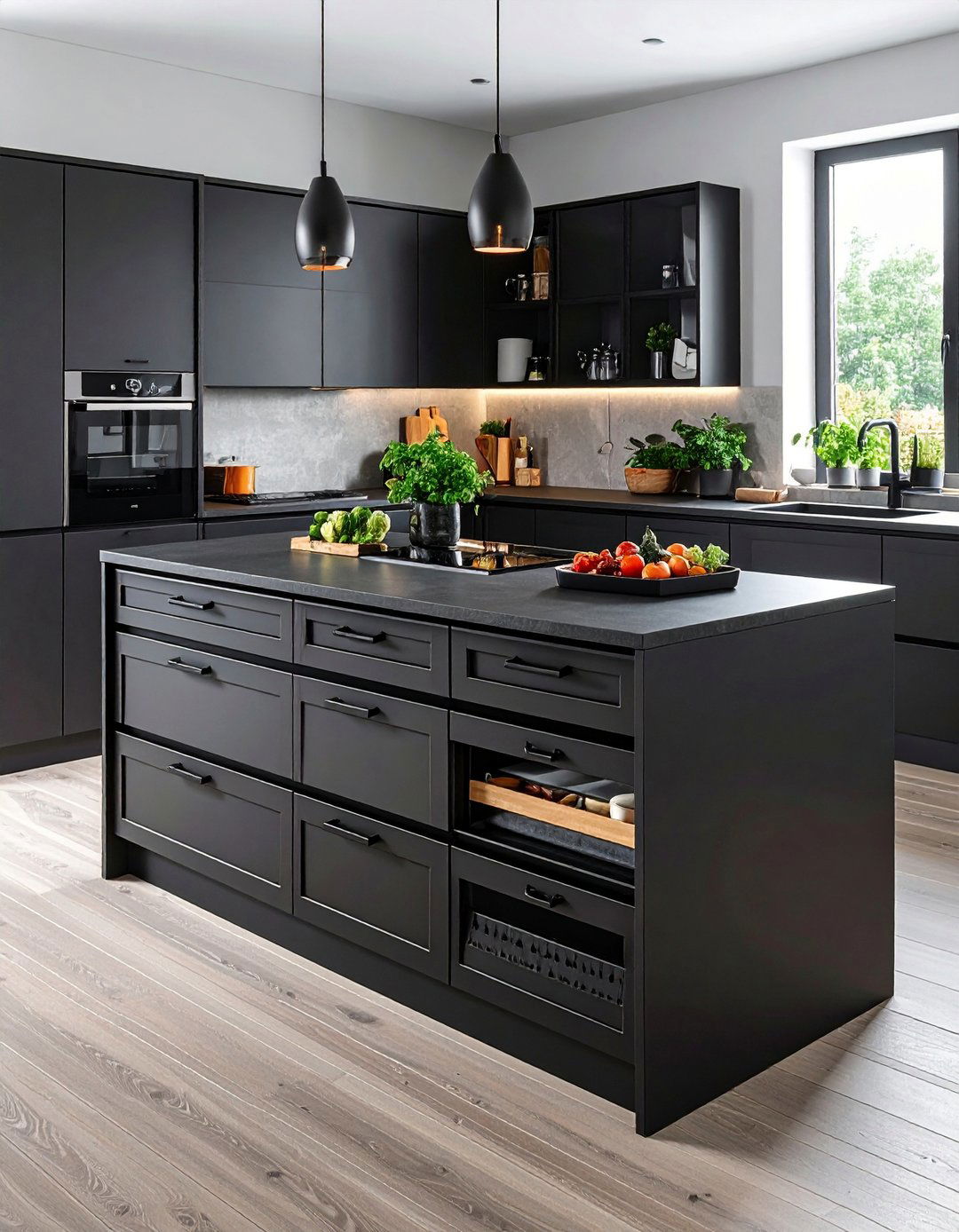



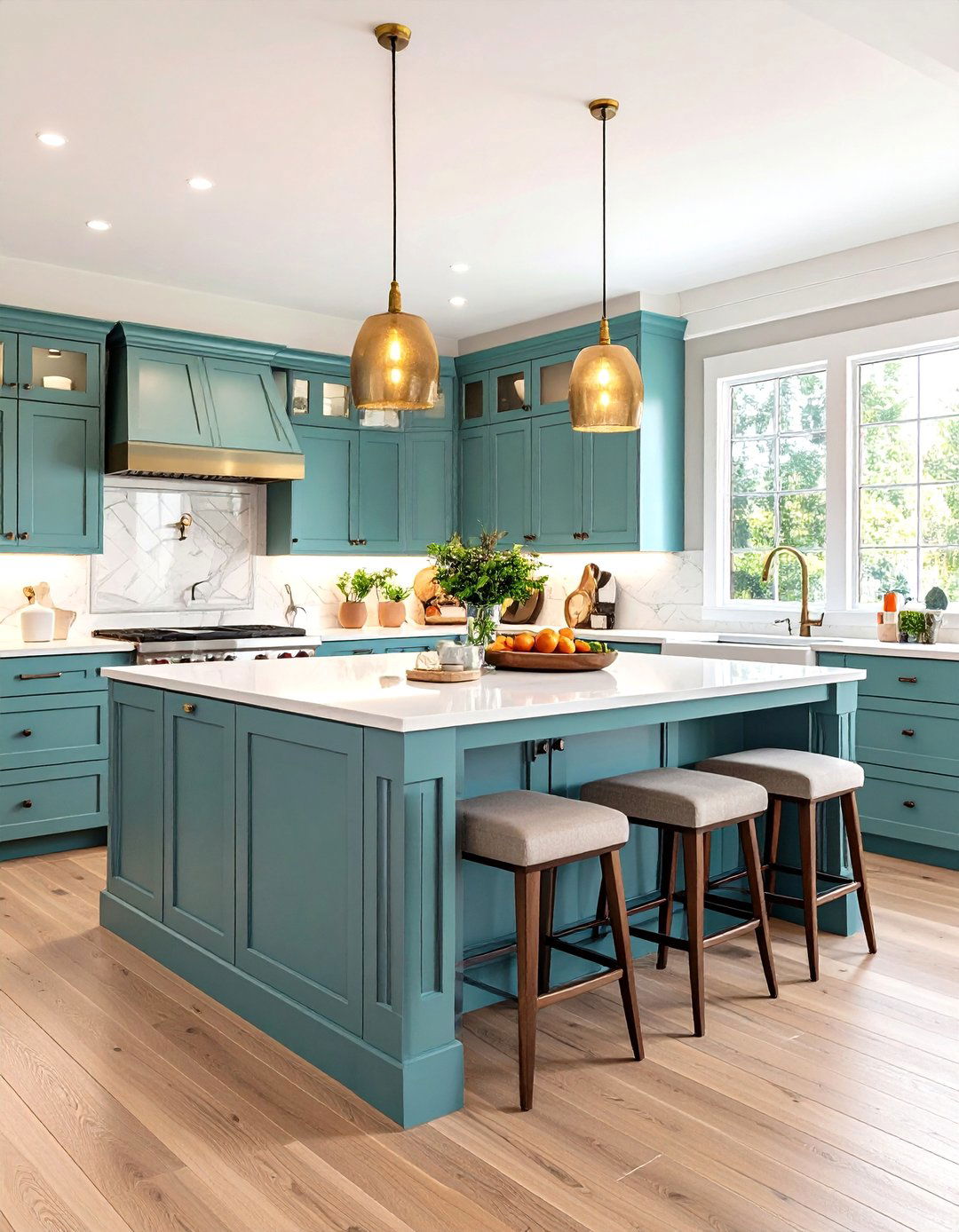

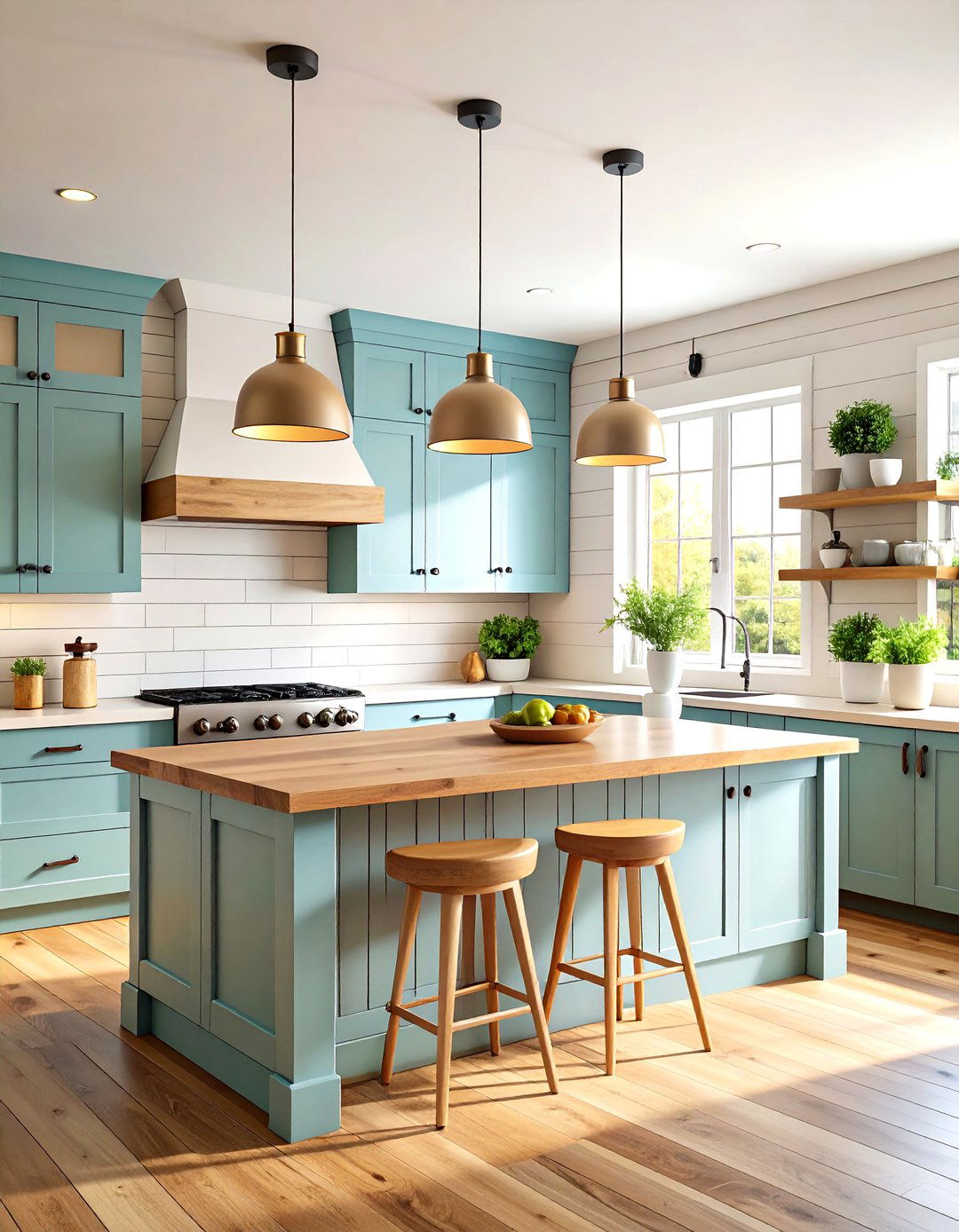
Leave a Reply